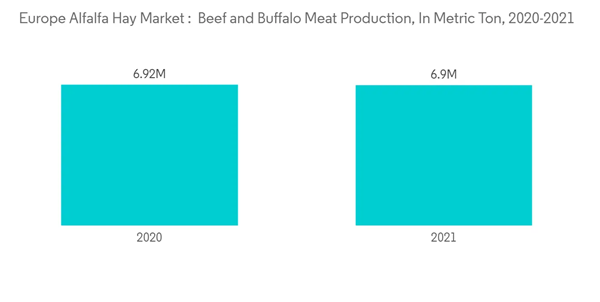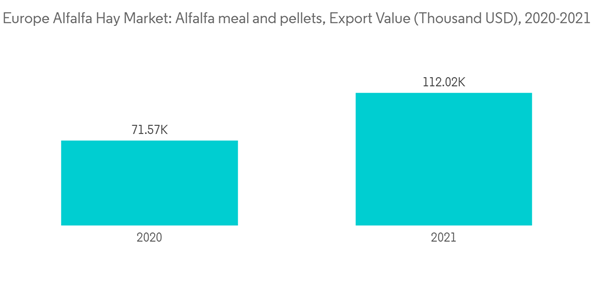Key Highlights
- In Europe, the major alfalfa-producing countries are Spain, France, and Italy. In Western Europe, Spain is the principal exporter of alfalfa hay, followed by France and Italy, thus contributing significantly to the European alfalfa hay market. Alfalfa acreage in Europe is devoted either to the production of dehydrated forage, mainly as hay. Because of its high agronomic potential and its ability to produce large amounts of protein per unit area, alfalfa has a role to play in European agriculture, even if some challenges have to be faced. A major effort should be devoted to harvesting machinery. For example, mowing machines equipped with roll conditioners would make it possible to speed up the drying process, thus reducing quality losses. On-farm barn drying is an emerging technique in some European regions, especially where high-quality products, such as protected-designation-of-origin cheeses, are produced.
- Alfalfa is extremely well adapted for such a production system, as it dries more quickly than other forages in the drying cells under ventilation. Alfalfa will keep an important place in European agriculture. Its favourable features can be further enhanced through technical and varietal innovation aimed at improved energy efficiency and reduced costs. The use of alfalfa hay has become critical to poultry feed, followed by animal feed in recent years, due to its importance of crude protein content. Owing to its nutritional benefits, dependence on alfalfa hay for animal feed may continue to drive the alfalfa hay market, globally, over the forecast period.
Europe Alfalfa Hay Market Trends
Increasing Demand for Dairy and Meat Products
Alfalfa hay is used primarily as an animal feed for dairy cows, horses, beef cattle, sheep, chickens, turkeys, and other farm animals. Alfalfa is harvested, stored, and fed to animals. It comes in many packaging sizes and forms; small, medium, and large rectangular bales, round bales, stack, pellets, cubes, and silage. Livestock is a major factor responsible for the growth of the alfalfa hay market in Europe. The EU is a major producer of beef and veal with a total herd of around 78 million cattle and are accounts for over 70 million sheeps and goats (85% sheep and 15% goats). The EU backs its farmers through income support payments. The European government is focusing on boosting the domestic production of alfalfa hay, in order to meet its high demand.The dairy sector is essentially boosting the demand for alfalfa hay in Europe. Until now, the EU has been able to increase agricultural productivity and thereby also production, which led to increasing trade surpluses. EU meat consumption was 67.5 kg per capita in 2020-2022. According to FAOSTAT, the production of beef and buffalo meat was 6,903.5 thousand ton. Production of sheep and goat meat was observed to be 577,490 ton in the year 2022. Furthermore, there has been an immense pressure on the livestock sector to meet the increasing demand for high-value animal protein. The demand for alfalfa hay is increasing significantly and is driven due to changing production practices in the dairy industry. This is essentially due to the increasing number of cows raised by modern dairy farmers who prefer quality feeds.
High Demand for Quality Forage
Alfalfa is considered to be the most important forage crop for providing protein to dairy and beef cattle, sheep, horses, birds, chickens, turkeys, and other livestock. Feeding alfalfa hay to lactating dairy cows has great health benefits for cattle. Alfalfa is one of the most important feed sources for animals worldwide, owing to its nutritional benefits. Alfalfa has the highest yield potential and the highest feeding value of all adapted forage legumes. It can be fed as chopped hay, pellet, or cubes. Quality alfalfa has high protein, vitamins, energy, and minerals. Alfalfa is highly digestible and contains more cell solubles, less cellulose, and hemicellulose, higher protein, low fiber, and higher relative feed value (RFV) than grass.Alfalfa is considered ideal hay also because of its availability. It is the only forage that is produced and sold everywhere. It contains between 15%-22% crude protein and is an excellent source of a wide range of vitamins and minerals. In addition to protein, alfalfa is a rich source of flavonoid antioxidants and phytoestrogens including luteolin, coumestrol, and apigenin. Micronutrients and some vitamins are essential for animals to achieve optimal immune function, growth, and reproduction. High quality alfalfa hay contains high percentage of leaves. Leaves provide 50-75% of the digestable matter, 75% of protien and 90% of carotene(relates to vitamin A content). A bright green color indicates proper curing an also indicates that hay is free of dust, mold and heat damage. Alfalfa provides these micronutrients to the cattle trhough the feed. It has the most feed value of all perennial pasture forages. Spain is one of the major producers of alfalfa, followed by France. Spain is the largest producer as well as exporter of alfalfa. Export value of alfalfa from Spain has increased form 2020 to 2021. The rich nutritional content of alfalfa and the need for quality feed for animals is boosting the market.
Europe Alfalfa Hay Industry Overview
The Europe alfalfa Hay market is highly fragmented. Companies not only compete on new product launches but also focus on strategic moves, such as mergers and acquisitions and expansion to acquire larger market shares. Some of the key players in the market are Alfalfa Monegros S L, Al Dahra Agriculture, Anderson Hay & Grain Inc., Cubeit Hay Company, and Grupo Osés. Major companies with help of product innovation, merger, and acquisition strategies are trying to compete in the market.Additional Benefits:
- The market estimate (ME) sheet in Excel format
- 3 months of analyst support
This product will be delivered within 2 business days.
Table of Contents
Companies Mentioned (Partial List)
A selection of companies mentioned in this report includes, but is not limited to:
- Alfalfa Monegros SL
- Anderson Hay & Grain Co.
- Aldahra Fagavi
- Cubeit Hay Company
- S&S Agrisource Holding LLC
- Grupo Oses
- The Accomazzo Company
- BORDER VALLEY TRADING
- Bailey Farms Inc.
- Coaba
- Al Dahra ACX Global Inc.
Methodology

LOADING...










